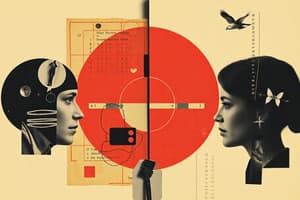Podcast
Questions and Answers
In cognitive psychology, what is the primary focus of study when using the 'mental rotation' task?
In cognitive psychology, what is the primary focus of study when using the 'mental rotation' task?
- Regulating emotional responses to cognitive tasks.
- Improving memory consolidation processes.
- Investigating spatial ability and mental imagery. (correct)
- Enhancing verbal processing speed.
Which theoretical perspective suggests that mental images are stored as abstract, symbolic representations rather than as analog, picture-like copies?
Which theoretical perspective suggests that mental images are stored as abstract, symbolic representations rather than as analog, picture-like copies?
- Action Cycle Theory
- Propositional theory (correct)
- Dual-code theory
- Functional-equivalence hypothesis
According to Paivio's (1985) framework, what are the two main functions that mental imagery serves?
According to Paivio's (1985) framework, what are the two main functions that mental imagery serves?
- Internal and external
- Motivational and cognitive (correct)
- Visual and kinesthetic
- Emotional and behavioral
What are the key characteristics that define the concept of problem solving?
What are the key characteristics that define the concept of problem solving?
Which aspect primarily differentiates a well-defined problem from an ill-defined problem?
Which aspect primarily differentiates a well-defined problem from an ill-defined problem?
How does a 'knowledge-lean' problem differ from a 'knowledge-rich' problem?
How does a 'knowledge-lean' problem differ from a 'knowledge-rich' problem?
What is the central tenet of Gestalt psychology concerning problem solving?
What is the central tenet of Gestalt psychology concerning problem solving?
According to the Gestalt approach, what distinguishes reproductive thinking from productive thinking in problem solving?
According to the Gestalt approach, what distinguishes reproductive thinking from productive thinking in problem solving?
In Khler's experiment with Sultan, the ape, what key observation suggested insight learning?
In Khler's experiment with Sultan, the ape, what key observation suggested insight learning?
In Birch's study, what crucial step enabled chimpanzees to successfully complete the food-raking task?
In Birch's study, what crucial step enabled chimpanzees to successfully complete the food-raking task?
In Maier's two-cord problem, what role did the 'hint' (brushing against a cord) play in participants finding the solution?
In Maier's two-cord problem, what role did the 'hint' (brushing against a cord) play in participants finding the solution?
How did Sultan's problem-solving approach differ from that of Birch's chimpanzees, and what does this suggest regarding insight versus trial and error?
How did Sultan's problem-solving approach differ from that of Birch's chimpanzees, and what does this suggest regarding insight versus trial and error?
In Duncker's candle problem, what is the primary obstacle preventing participants from finding the optimal solution?
In Duncker's candle problem, what is the primary obstacle preventing participants from finding the optimal solution?
In the context of Duncker's candle problem, what cognitive shift occurs when participants discover the optimal solution?
In the context of Duncker's candle problem, what cognitive shift occurs when participants discover the optimal solution?
What is functional fixedness, and how does it impact problem solving?
What is functional fixedness, and how does it impact problem solving?
How does increased experience with objects typically affect functional fixedness as individuals age?
How does increased experience with objects typically affect functional fixedness as individuals age?
In Luchins' Water Jar study, what was the 'Einstellung' effect?
In Luchins' Water Jar study, what was the 'Einstellung' effect?
What was the key difference between the experimental and control groups in Luchins' Water Jar study?
What was the key difference between the experimental and control groups in Luchins' Water Jar study?
According to the Gestalt approach, what is a primary limitation in the study of problem solving?
According to the Gestalt approach, what is a primary limitation in the study of problem solving?
In the cognitive approach to problem solving, what is meant by 'problem space'?
In the cognitive approach to problem solving, what is meant by 'problem space'?
According to Newell and Simon's theory, what is the essence of problem solving?
According to Newell and Simon's theory, what is the essence of problem solving?
What crucial assumption does the 'General Problem Solver' make?
What crucial assumption does the 'General Problem Solver' make?
In the Tower of Hanoi problem, what is the primary rule that must be followed when moving disks?
In the Tower of Hanoi problem, what is the primary rule that must be followed when moving disks?
In the Tower of Hanoi problem, what constitutes the 'goal state'?
In the Tower of Hanoi problem, what constitutes the 'goal state'?
According to Newell and Simon, what are the two main heuristics used to select operations in problem solving?
According to Newell and Simon, what are the two main heuristics used to select operations in problem solving?
How does 'hill-climbing' differ from 'means-end analysis'?
How does 'hill-climbing' differ from 'means-end analysis'?
How does the Representational Change Theory enhance our understanding of insight compared to the Gestalt theory?
How does the Representational Change Theory enhance our understanding of insight compared to the Gestalt theory?
Which of the following are key to the Representational Change Theory?
Which of the following are key to the Representational Change Theory?
According to Knoblich et al.'s eye-tracking study, what was the key distinction observed in participants that were and were not able to solve the matchstick problem?
According to Knoblich et al.'s eye-tracking study, what was the key distinction observed in participants that were and were not able to solve the matchstick problem?
How can can prior experience both help and hinder problem solving?
How can can prior experience both help and hinder problem solving?
What is a potential specific to the Cognitive Approach?
What is a potential specific to the Cognitive Approach?
What is the main idea that is emphasized by the Gestalt approach to problem solving?
What is the main idea that is emphasized by the Gestalt approach to problem solving?
Which of the following is true? The Gestalt approach...
Which of the following is true? The Gestalt approach...
In the cognitive approach to problem-solving, what is the significance of the 'goal state' within the problem space?
In the cognitive approach to problem-solving, what is the significance of the 'goal state' within the problem space?
How does the cognitive approach to problem solving conceptualize the process of moving from the initial state to the goal state?
How does the cognitive approach to problem solving conceptualize the process of moving from the initial state to the goal state?
What three items are given to participants for Duncker's 'Candle Problem'?
What three items are given to participants for Duncker's 'Candle Problem'?
What is the task during 'Candle Problem'?
What is the task during 'Candle Problem'?
In the context of insight and problem-solving, what is meant by 'constraint relaxation,' as described in the Representational Change Theory?
In the context of insight and problem-solving, what is meant by 'constraint relaxation,' as described in the Representational Change Theory?
Compared to that of Gestalt, how has RT changed the discussion of insight problem solving?
Compared to that of Gestalt, how has RT changed the discussion of insight problem solving?
Flashcards
Problem Solving
Problem Solving
Problem solving involves achieving a goal when the solution isn't immediately obvious, requiring cognitive processes and lacking relevant knowledge for an immediate solution.
Well-defined problem
Well-defined problem
Involves clearly defined goals, specified information, and obvious steps.
Ill-defined problem
Ill-defined problem
Characterized by unspecified aspects, unclear goals, and uncertain relevant information, making solutions less obvious.
Knowledge-rich problem
Knowledge-rich problem
Signup and view all the flashcards
Knowledge-lean problem
Knowledge-lean problem
Signup and view all the flashcards
Gestalt Psychology
Gestalt Psychology
Signup and view all the flashcards
Reproductive thinking
Reproductive thinking
Signup and view all the flashcards
Productive thinking
Productive thinking
Signup and view all the flashcards
Insight
Insight
Signup and view all the flashcards
Functional Fixedness
Functional Fixedness
Signup and view all the flashcards
Einstellung Effect
Einstellung Effect
Signup and view all the flashcards
Problem space
Problem space
Signup and view all the flashcards
Problem Solving (Cognitive)
Problem Solving (Cognitive)
Signup and view all the flashcards
Means-end analysis
Means-end analysis
Signup and view all the flashcards
Hill-climbing
Hill-climbing
Signup and view all the flashcards
Elaboration
Elaboration
Signup and view all the flashcards
Constraint Relaxation
Constraint Relaxation
Signup and view all the flashcards
Re-encoding
Re-encoding
Signup and view all the flashcards
Study Notes
- Cognitive Psychology Lecture 6 focuses on problem-solving, exploring definitions, types of problems, and approaches to solving them.
Mental Rotation Task
- This task is often used to study spatial ability and mental imagery
- Most participants (92%) chose the correct answer in a poll
Mental Images
- Propositional theory suggests that mental images are stored as abstract propositional codes, not picture-like representations
- 73% of poll participants agreed with this theory.
Mental Imagery
- Paivio's (1985) framework identifies the two primary functions of mental imagery as motivational and cognitive
- A majority of poll participants (65%) selected this option.
Definition of Problems
- Problem-solving involves a situation where an organism has a goal but lacks the knowledge to immediately reach it
- Problem-solving has three major characteristics: it is goal-directed, requires cognitive processes, and occurs when there is a lack of relevant knowledge for an immediate solution.
Well-Defined vs. Ill-Defined Problems
- Well-defined problems have all aspects specified, with a clear goal and all information clearly stated, such as assembling flat-pack furniture, escaping a maze, or solving arithmetic problems.
- Ill-defined problems have some unspecified aspects, it is not obvious when the goal has been reached or what information is relevant, such as deciding how to vote, writing an essay, or choosing a career path.
Knowledge-Rich vs. Knowledge-Lean Problems
- Knowledge-rich problems require specific prior knowledge, demonstrated by writing a psychology essay or solving a crossword.
- Knowledge-lean problems require little prior knowledge, as all the necessary information to solve the problem is contained within it, such as solving Sudoku
Gestalt Approach to Problem Solving
- Gestalt psychology, emerging in the early 20th century in Austria and Germany, focuses on the processing of entire patterns and configurations rather than individual components.
- A key idea is that the whole is greater than the sum of its parts, meaning we perceive things as unified wholes rather than separate elements.
Reproductive Thinking
- Reproductive thinking relies on experience to solve problems, a typical example of this is trial and error learning.
Productive Thinking
- Productive thinking involves creating new responses or strategies to solve a problem, requiring restructuring the problem by mentally simulating possible solutions.
- With productive thinking, a problem can be solved by engaging in mental simulation
- The problem must be restructured so that the solution becomes suddenly clear, resulting in an insight.
Insight Learning
- Kohler (1925) demonstrated insight learning with Sultan the ape, who, when placed in a cage with a banana out of reach, initially tried jumping to reach it but failed.
- Sultan then had an "Aha!" moment, realizing he could use a box as a tool to reach the banana, moving the box, climbing on it, and succeeding.
Insight in Chimpanzees
- Birch (1945) found that chimpanzees presented with a food-raking task initially struggled to use sticks to retrieve food, however, after exposure to the sticks without the food present, all chimps succeeded in solving the problem.
Two-Cord Problem
- Maier (1931) designed the two-cord problem, where participants had to tie two cords together that were too far apart to reach at the same time, using available tools such as poles, clamps, pliers, extension cords, and a chair.
- The elegant solution involved attaching a weight to one cord to make it swing like a pendulum
- When participants were stuck, Maier would give a subtle hint, setting one of the cords in motion.
- Most participants then came up with the pendulum solution.
The Candle Problem
- Duncker's (1945) Candle Problem gave participants a candle, thumbtacks, and matches, tasking them to attach the lit candle to a wall without dripping wax on the table.
- The optimal solution involves emptying the box of thumbtacks, nail the box to the wall, place the candle in the box, and light it with a match.
- Many participants initially tried ineffective methods, such as tacking the candle directly to the wall or trying to melt the candle to stick it.
Functional Fixedness
- Once participants realized the optimal solution to the candle problem they no longer perceived the box solely as a container (85%)
Functional Fixedness
- Functional fixedness is a cognitive bias that limits a person's ability to use objects in ways other than their intended purpose, hindering problem-solving and creative thinking.
- As people age and gain more experience with objects, they become more likely to associate them with fixed functions.
Water Jar Study
- Luchins (1942) conducted the Water Jar Study, in which participants were given three jars of different capacities and asked to measure out a specific amount of water.
- The experimental group was given five practice problems that required using a specific formula, B - A - 2*C whereas control group was not given the practice problems and directly attempted the test problems.
- Participants in the experimental group tended to stick with it, even when simpler solutions were available
- Participants in the control group, had no prior exposure to the formula, were more likely to find the simpler solutions.
The Einstellung Effect
- The Einstellung effect is a tendency to rely on a familiar problem-solving strategy even with a simpler solution available.
Gestalt Approach Evaluation
- This approach introduced and investigated insight as a problem-solving method
- Representational change and restructuring was emphasized, and showed that experience does not always help
- Focuses on knowledge-lean, well specified problems, insight and restricting is considered vague
- Describes what happens during problem solving, but not how it happens
Cognitive Approach
- Problem-solving is conceptualized as a series of cognitive operations that transform information from one state to another
- Problem space represents of a problem, initial state of the problem as it is represented, allowable operations to change the state of the problem, all possible problem states between the initial state and the goal state, and the goal state
- Problem-solving involves changing the initial state into the goal state through intermediate states (i.e., processing information).
- Operations change the problem state; this can be called 'searching' the problem space.
General Problem Solver
- Newell & Simon (1972) developed a computer simulation called "General Problem Solver"
- This was based on the 'think aloud' paradigm, where participants verbalized their thought processes, and retrospective interviews, designed to solve problems with a clear goal state
- The assumptions it makes are, information processing is serial, limited short-term memory capacity and relevant information can be retrieved from memory.
Tower of Hanoi
- The Tower of Hanoi involves moving a stack of disks of different sizes from one peg to another, following the rule that only one disk can be moved at a time and no larger disk may be placed on top of a smaller disk.
Tower of Hanoi Moves
- The minimum number of moves required to transfer all disks from the leftmost peg to the rightmost peg is 7
Operations Selected
- Newell & Simon (1972) described two heuristics
- Means-end analysis identifies the difference between the current and goal state, forms a subgoal to reduce this difference, and performs operations to attain the subgoal, like following instructions to assemble IKEA furniture.
- Hill-climbing is changing the current state to something that more closely resembles the goal when you don't know how to solve the problem (assembling IKEA furniture without instructions)
Representational Change Theory
- This is a cognitive theory of problem-solving that explains how people overcome impasses and achieve insights, particularly in challenging problems
- There are 3 ways to change representation of problems:
- Elaboration, adding more information about the problem
- Constraint relaxation, changing what is permissible to solve the problem
- Re-encoding changing how some aspect of the problem is interpreted
- This is similar to the Gestalt theory, also more specific about how insight is achieved
Importance of Constraint Relaxation
- Knoblich et al., (2001) explored the importance of constraint relaxation by having 24 participants solve matchstick arithmetic problems while recording their eye movements.
- Chunk decomposition (CD) problems require moving a single matchstick from one numeral to another
- Operator decomposition (OD) problems involve changing the operator by moving a matchstick.
- Those who solved the problem paid more attention to the operators, helped to overcome initial fixation purely changing numerical values
Cognitive Approach Evaluation
- Ideas of problem space and heuristic search critical to understanding problem-solving
- Works well with problems that are well defined and short on knowledge, restructuring helps with problems that may be insightful
- The General Problem Solver may not function as humans do, is better at remembering previous states, and cannot plan as many future moves at a time as humans
- This is not a general theory of problem solving
Summary
- Gestalt approach emphasizes the concept of 'insight' from the mental simulation of possible solutions.
- The cognitive approach presents simulation as information processing.
- Two key concepts are: Problem Space and Heuristic Search
- Representational Change Theory gives insight into how problems can be restructured to generate insight.
Studying That Suits You
Use AI to generate personalized quizzes and flashcards to suit your learning preferences.




